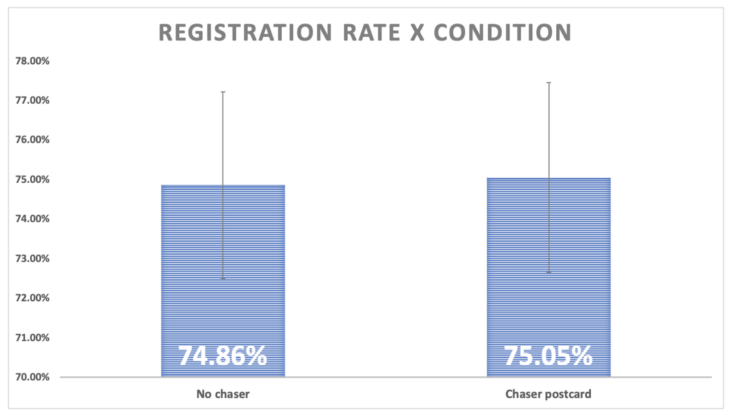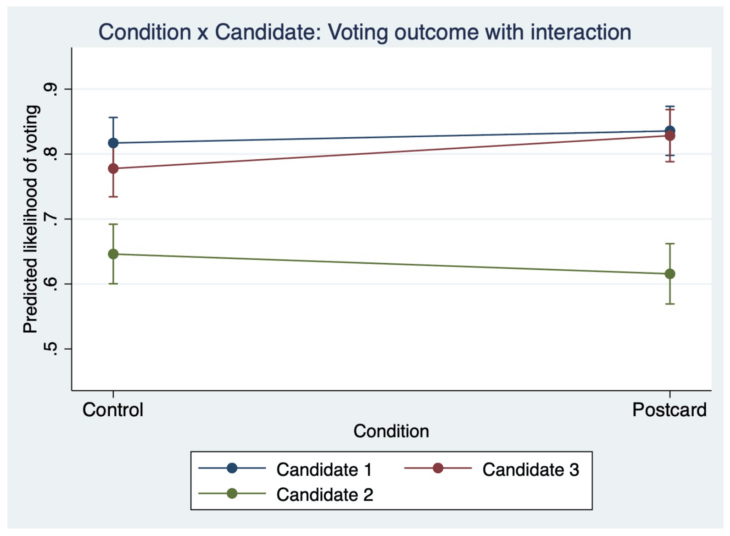Abstract: This pilot study, conducted by Sister District Action Network (SDAN) in 2019, tested whether sending a handwritten postcard to a voter, to follow up on a successful voter contact made by a campaign earlier that year, could increase voter turnout. Three state legislative campaigns provided SDAN with a list of voters that they had successfully contacted through phonebanking or canvassing (i.e., they had actually contacted them vs just attempting to) and who had identified themselves as supporters of the candidate. A randomly chosen half of these voters received a handwritten GOTV postcard shortly before the election reminding them of the contact they had with the campaign and encouraging them to vote, as well as providing information about how to vote. The other half received no postcard. The raw numbers trended in the expected direction, with more people in the postcard chaser condition voting than people who did not receive a postcard, though this difference was not statistically significant (p = 0.406). Interestingly, the postcards were fairly effective in one of the campaigns (candidate 3), while they were fairly ineffective or had backlash in the other two (candidates 1 and 2). This suggests that effects range in size based on unidentified underlying factors associated with campaigns, locations, or other factors.
Objective: This pilot study explored the utility of sending handwritten chaser postcards to voters who have been identified as supporters after a successful voter contact as a way to increase turnout.
Background: Handwriting postcards has emerged as a popular volunteer tactic in the past few years. However, little is known about the most effective uses of postcards. SDAN has conducted several postcarding studies, including two that suggest that chaser postcarding, where the postcard follows another contact is one way to increase the efficacy of postcards (see here and here). Further, several studies indicate that phonebanking and canvassing are useful tactics for campaigns (see here and here). SDAN combined these tactics in order to explore how well chaser postcards sent to amplify a positive phonebanking or canvassing contact might work to mobilize voters to the polls.
Specifics: Three legislative candidates across two states (Mississippi, Louisiana) worked with SDAN to chase supporters who were identified through a canvass or phonebank. Campaigns provided SDAN with contact information for voters who had 1) expressed that they leaned towards supporting or definitely supported the candidate, and 2) partisanship scores of 60-100 indicating that they were likely to vote for Democrats. SDAN randomly chose half of these voters to receive a handwritten “Get Out the Vote” (GOTV) postcard shortly before the general election. The postcard message reminded voters about the contact they had with the campaign and provided them with information and encouragement to vote. The other half received no postcard.
Sister District volunteers hand wrote the postcards and sent them to the campaign office. Campaigns mailed the postcards locally, with estimated delivery to homes from October 28-30, 2019 in Mississippi and November 7-9, 2019 in Louisiana (Louisiana has a “jungle primary” system that had a general election in place of a primary on October 12, 2019, and a runoff election for any races where candidates did not exceed 50% on November 16, 2019; many high profile races like Governor were on the November ballot in 2019). Overall, 1,058 voters in the analysis received postcards and 1,090 voters were enrolled in the control condition, for a total of 2,148. Since several targets were in the same household according to the TargetSmart voter file, we controlled for household as a random effect in the analysis.
Basic Takeaways
- Voters who received a chaser postcard did vote more than those who did not receive a postcard, but this effect was not statistically significant (p = 0.406).
- There was a significant interaction (p = 0.043) that suggested that one candidate did benefit from the postcards, while another candidate saw a slight decrease in voter turnout among postcard receivers. Interestingly, the candidate who benefitted was in a runoff election, while the other two candidates were not. This indicates that runoff elections may be good environments for chaser postcards to work well, and should be studied more.
- The initial evidence from the pilot indicates this may be a useful tactic to explore further. But it’s important to note that this work has several caveats which limit its generalizability (see caveats and considerations).
Key findings
- People in the postcard chaser condition voted at a slightly higher rate than control participants, but this difference was not statistically significant.
- The voter turnout for people who received a chaser postcard was 75.05%, while people who did not receive a chaser postcard voted at a rate of 74.86%. This difference of 0.19% was not statistically significant (p = 0.406). This indicates that receiving a chaser postcard was associated with a small boost in turnout, but it was not statistically meaningful in this sample.

- The voter turnout for people who received a chaser postcard was 75.05%, while people who did not receive a chaser postcard voted at a rate of 74.86%. This difference of 0.19% was not statistically significant (p = 0.406). This indicates that receiving a chaser postcard was associated with a small boost in turnout, but it was not statistically meaningful in this sample.
- Effects varied by candidate, with one candidate seeing a boost in voting rate from postcards and one candidate seeing a slight decrease in voting rate.
- An interaction between two of the candidates, one in Mississippi and one in Louisiana, was statistically significant (p = 0.043), indicating that postcards behaved differently for these two candidates. A graph of the interaction shows the likelihood of voting decreasing slightly for voters who received postcards in one of the Mississippi campaigns while the voting rate increased slightly among voters targeted in the Louisiana race.
- The third candidate (candidate 1) saw a very slight increase in turnout among voters who received chaser postcards but not statistically significantly larger than control participants who voted at similar rates.
- This means that chaser postcards performed differently based on the specific campaign they were used in. These effects are unexpected and unexplained with the current data. One potential explanation is that the lists from each candidate were made up of qualitatively different types of voters who behaved differently. Another is that runoffs may be different from typical general elections. These quieter elections are an area that should be explored further.

- An interaction between two of the candidates, one in Mississippi and one in Louisiana, was statistically significant (p = 0.043), indicating that postcards behaved differently for these two candidates. A graph of the interaction shows the likelihood of voting decreasing slightly for voters who received postcards in one of the Mississippi campaigns while the voting rate increased slightly among voters targeted in the Louisiana race.
Caveats and considerations
- Study used a unique sample of voters. The sample in this study came from the group of registered voters who 1) lived in these 3 state legislative candidates’ districts, 2) had been successfully contacted by that campaign, 3) had expressed campaign support, and 4) had partisanship scores of 60+, indicating likelihood of voting for Democratic candidates. For this reason, these results should not be widely generalized.
- Some of the participants lived together. After the completion of the study it was determined that several participants lived at the same addresses, indicating that they share a household. This was controlled for in the analysis, but it presents challenges in determining who actually received the postcards, as well as how sharing a household with other supporters of the candidate affected voters in the study.
- This study was statistically underpowered. That means that it did not have a large enough sample for an effect of this size to be statistically significant. A larger study was run in the Fall of 2020 to partially address this issue, and we will release the results when they are available.
Contributions and Future Directions
This study adds to SDAN’s research on the best practices for postcarding. Even though results were not significant in this pilot study, it provided some intriguing indicators that chaser postcards may be a useful tactic.
It also tested a relatively novel use for postcarding, specifically as a way to boost the utility of a canvassing or phone banking contact. Since these are common campaign activities, knowing how to amplify the effects of a successful canvass or phone conversation with an easily scalable tactic would be beneficial for campaigns. More research is needed to determine if this is the case with chaser postcards that follow up on a campaign contact.
If you’re interested in reading more about this study, a longer report is here.
SDAN’s commitment: It is SDAN’s intention to provide as much context as possible to allow for the nuanced interpretation of our data. SDAN’s convention is to contextualize effects by reporting p values, confidence intervals, and effect sizes for all models tested (these items may be in the longer report linked in the blog). Additionally, SDAN always differentiates between planned and exploratory analyses and a priori and post hoc tests, and reports the results of all planned analyses regardless of statistical significance. If you have questions about these findings please email Mallory.





